March 20, 2009
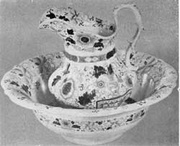
This article, written by the Brooklyn Museum’s then-Curator of Decorative Arts, discusses the global influence on American ceramics in the 19th century, using the china found at the Sunnyside house (Washington Irving’s home) as an example. It notes the types of china produced, the decorative characteristics, and the various manufacturers and production processes. It also describes public reaction to the introduction of the bath tub and details a typical 19th century dinner party. It originally appeared … (continue reading)
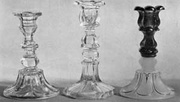
This article on the Sandwich Glass Company’s glass candlesticks, made in the mid- to late 19th century, focuses on the production processes, the designs’ inspiration (Venetian glassblowers), and the various colors and styles that were most available at the time the article was published. It originally appeared in the December 1937 issue of American Collector magazine, a publication which ran from 1933-1948 and served antique collectors and dealers.
The dolphin candlestick and its various half brothers, the … (continue reading)
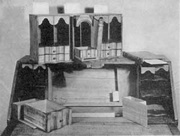
This article discusses hidden compartments found in antique furniture pieces, especially desks and secretaries, and describes some examples with multiple secret compartments. It originally appeared in the November 1939 issue of American Collector magazine, a publication which ran from 1933-1948 and served antique collectors and dealers.
Secret compartments for money, securities, ancestral jewelry and silver plate, a missing will, or a carefully written confession of a crime committed years before, have served fiction writers well. In fact, … (continue reading)

This article focuses on 19th-century night lights known as fairy lamps, which were the first lamps that were safe to leave on without supervision. It describes advertisements for the lamps, as well as their multiple uses (from discouraging burglars to calming children afraid of the dark) and various designs. It originally appeared in the September 1940 issue of American Collector magazine, a publication which ran from 1933-1948 and served antique collectors and dealers.
Some years ago a police … (continue reading)

In this article, the author notes what she perceives as a decline in the standard of glass collecting at the time of publishing and addresses fads, the definition of “antique,” and reproductions. It originally appeared in the March 1941 issue of American Collector magazine, a publication which ran from 1933-1948 and served antique collectors and dealers.
On a cycle as constant as the seven-year locust, though more frequent, magazines devoted to fashions and the home have published … (continue reading)

This article on ceramic portraiture in the 17th and 18th centuries focuses on notable potters and artists, the various figures that were produced (from homely figurines such as courting couples to important people, such as Queen Anne and Sir Isaac Newton), as well as the history of the art form. It originally appeared in the September 1939 issue of American Collector magazine, a publication which ran from 1933-1948 and served antique collectors and dealers.
Although English artists began … (continue reading)

This article details the silver plate that belonged to Captain Tobias Lear, the father of George Washington’s secretary (and close friend) Colonel Tobias Lear. It describes the various pieces in the set and identifies the manufacturers using the makers’ marks. It originally appeared in the December 1937 issue of American Collector magazine, a publication which ran from 1933-1948 and served antique collectors and dealers.
It is a matter of general observation that in this country family possessions tend … (continue reading)
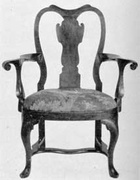
This article addresses the popularity of Queen Anne furniture in America in the first half of the 18th century, noting the major differences in design between the American and English styles. It originally appeared in the October 1939 issue of American Collector magazine, a publication which ran from 1933-1948 and served antique collectors and dealers.
Whole books, and many of them, have been written about American furniture of various periods and special localities but one of the … (continue reading)
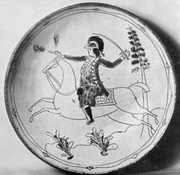
This article on slipware (pottery with pinpricked designs) made in Pennsylvania focuses on the processes and methods used to create slipware, as well as the history of the pottery and some of the most notable designers and manufacturers. It originally appeared in the December 1940 issue of American Collector magazine, a publication which ran from 1933-1948 and served antique collectors and dealers.
A goal for the collector is old pin-decorated slipware. Even run-of-the-mill slipware does not … (continue reading)
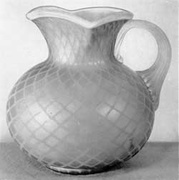
This article discusses colorful blown glass produced predominantly at the New England Glass Company and the Mount Washington Glass Company (although also attempted by various other glass manufacturers) in the 19th century. It notes some of the most talented craftsmen and innovative colors of the time, and provides a step-by-step explanation of the process of creating colored glass, illustrating the differences in production compared with normal overlay glass. It originally appeared in the January 1940 issue of … (continue reading)

This article focuses on the history of the Sandwich Glass Company, established in 1825, and describes the wide variety of patterns that the company produced and their movement from clear flint glass to the production of as many colors as possible. It originally appeared in the November 1940 issue of American Collector magazine, a publication which ran from 1933-1948 and served antique collectors and dealers.
Lacy Sandwich glass was one of the earliest, if not the first, … (continue reading)
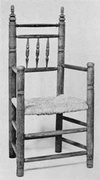
This article discusses slat-back chairs throughout the 17th, 18th, and 19th centuries – specifically the countries they were made in, the varying styles, and their evolution from a crudely-made country chair to an elaborately designed piece of furniture, and then back to a plainer, more simplistic utilitarian item. It originally appeared in the January 1941 issue of American Collector magazine, a publication which ran from 1933-1948 and served antique collectors and dealers.
A winter or two ago … (continue reading)
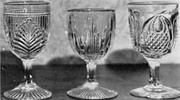
This article talks about the process and the benefits of one-of-a-kind collecting – collecting individual items that work together rather than looking for a full set in the same pattern. It originally appeared in the May 1940 issue of American Collector magazine, a publication which ran from 1933-1948 and served antique collectors and dealers.
There is twelve times as much fun in one-of-a-kind collecting, according to the devotees of the mixed dozen! Goblets, tumblers, sauce dishes – … (continue reading)
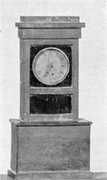
This article on the clockmaker Simon Willard describes the characteristics associated with Willard’s craftsmanship, detailing some of his specific clocks to illustrate. It also notes the French influence on American clockmaking. It originally appeared in the June 1939 issue of American Collector magazine, a publication which ran from 1933-1948 and served antique collectors and dealers.
The name Simon Willard has always stood for superior materials, whether metal or wood; superior workmanship, whether of the movements he … (continue reading)

This article, written by the curator of the James Arthur Collection of Clocks and Watches at New York University, discusses clockmaking in the 18th and 19th centuries, noting the rise and fall of the independent clockmaker, the movement away from quality items to clocks that could be sold cheaply, and the differences between public and domestic clocks. It originally appeared in the November 1937 issue of American Collector magazine, a publication which ran from 1933-1948 and … (continue reading)















 Scopitone: '60s Music Videos You've Never Seen
Scopitone: '60s Music Videos You've Never Seen Beer Money and Babe Ruth: Why the Yankees Triumphed During Prohibition
Beer Money and Babe Ruth: Why the Yankees Triumphed During Prohibition Christie Romero on Differences Between Fine and Costume Jewelry Over the Decades
Christie Romero on Differences Between Fine and Costume Jewelry Over the Decades Formula for Beauty: The Geo-Chemistry Behind Rookwood Pottery
Formula for Beauty: The Geo-Chemistry Behind Rookwood Pottery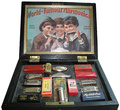 How a Gang of Harmonica Geeks Saved the Soul of the Blues Harp
How a Gang of Harmonica Geeks Saved the Soul of the Blues Harp Mari Tepper: Laying it on the Line
Mari Tepper: Laying it on the Line Nice Ice: Valerie Hammond on the Genteel Charm of Vintage Canadian Costume Jewelry
Nice Ice: Valerie Hammond on the Genteel Charm of Vintage Canadian Costume Jewelry How Jim Heimann Got Crazy for California Architecture
How Jim Heimann Got Crazy for California Architecture Modernist Man: Jock Peters May Be the Most Influential Architect You've Never Heard Of
Modernist Man: Jock Peters May Be the Most Influential Architect You've Never Heard Of Meet Cute: Were Kokeshi Dolls the Models for Hello Kitty, Pokemon, and Be@rbrick?
Meet Cute: Were Kokeshi Dolls the Models for Hello Kitty, Pokemon, and Be@rbrick? When the King of Comedy Posters Set His Surreal Sights on the World of Rock 'n' Roll
When the King of Comedy Posters Set His Surreal Sights on the World of Rock 'n' Roll How One Artist Makes New Art From Old Coloring Books and Found Photos
How One Artist Makes New Art From Old Coloring Books and Found Photos Say Cheese! How Bad Photography Has Changed Our Definition of Good Pictures
Say Cheese! How Bad Photography Has Changed Our Definition of Good Pictures Middle Earthenware: One Family's Quest to Reclaim Its Place in British Pottery History
Middle Earthenware: One Family's Quest to Reclaim Its Place in British Pottery History Fancy Fowl: How an Evil Sea Captain and a Beloved Queen Made the World Crave KFC
Fancy Fowl: How an Evil Sea Captain and a Beloved Queen Made the World Crave KFC